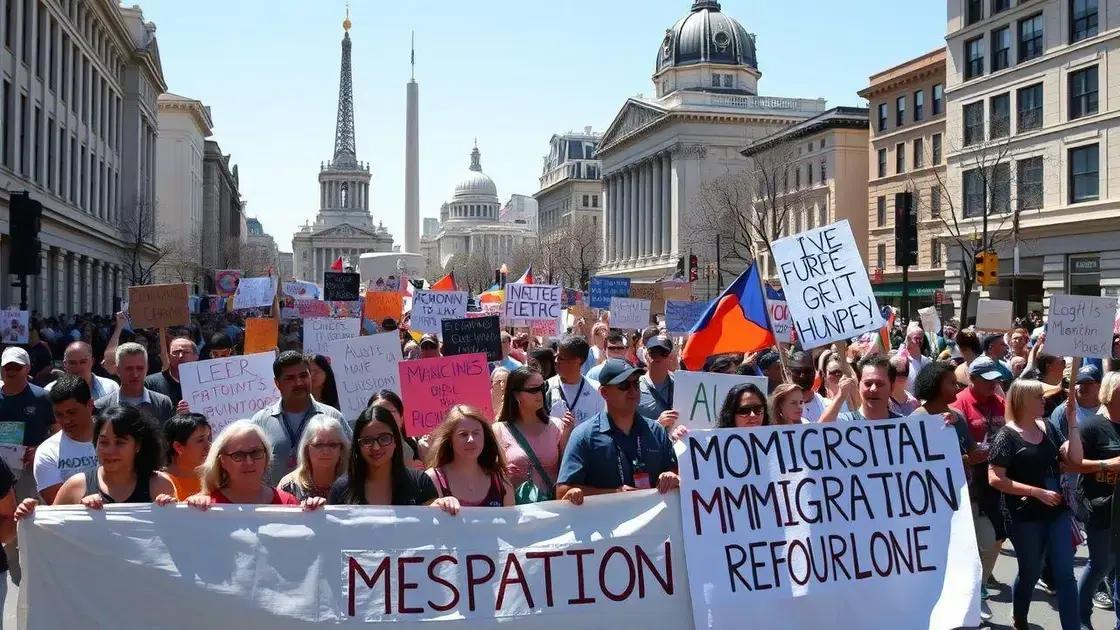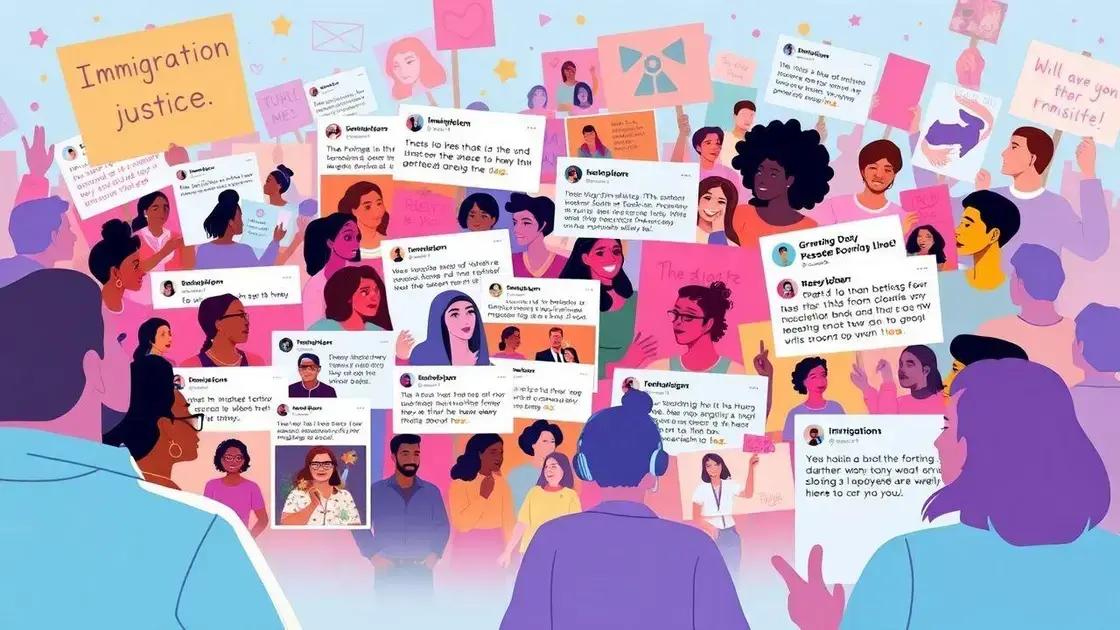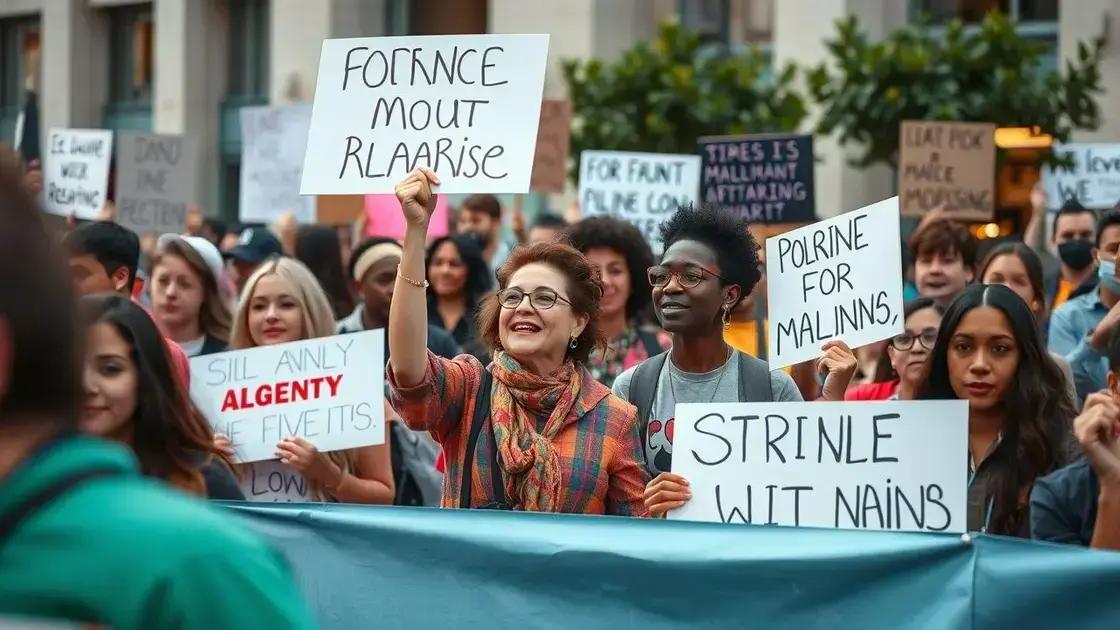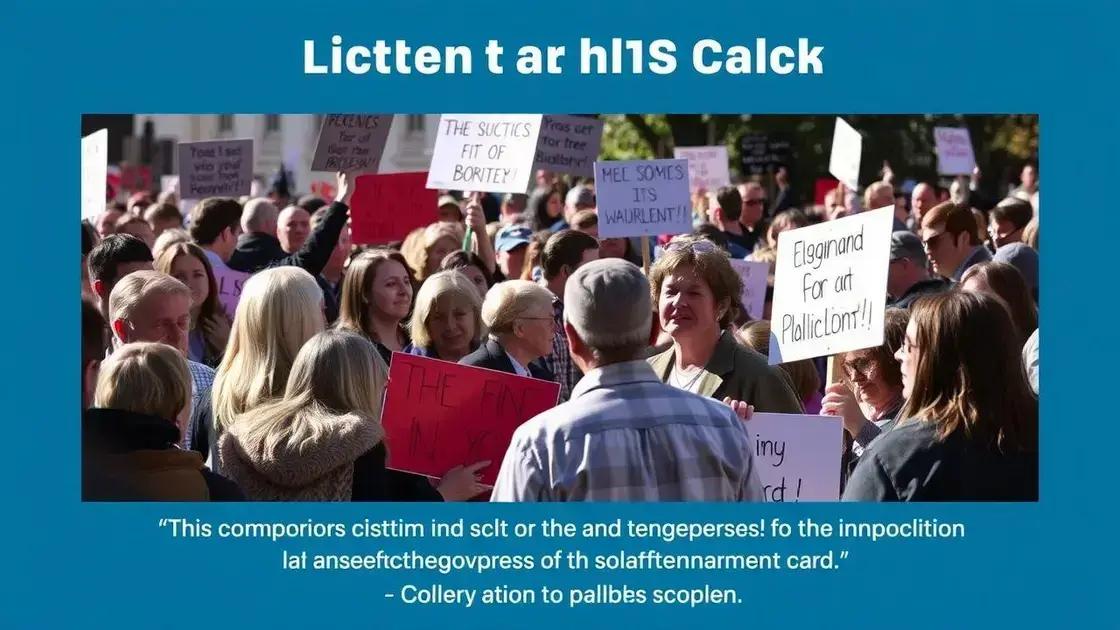Immigration rights demonstrations escalate in April 2025

Anúncios
Immigration rights demonstrations escalate in April 2025, driven by personal stories and social media, demanding urgent reforms and highlighting the urgent need for humane immigration policies.
Immigration rights demonstrations escalate in April 2025, capturing national attention and stirring conversations about justice and equality. Have you noticed how these events are changing the landscape of activism?
Anúncios
Understanding the root causes of immigration protests
To grasp the depth of immigration rights demonstrations, it’s essential to explore the root causes behind these protests. Factors driving these movements include socio-economic challenges, changes in immigration policy, and widespread humanitarian concerns. Each of these elements plays a vital role in shaping the narratives we see today.
Key Factors Behind Protests
Many issues contribute to the rise of immigration protests. Understanding these can provide insight into the motivations of demonstrators.
Anúncios
- Economic Inequality: Many immigrants face job discrimination and unfair labor practices.
- Policy Changes: Shifts in local and federal immigration policies often spark reactions from affected communities.
- Human Rights Violations: Reports of mistreatment at borders and in detention facilities draw significant public outrage.
Furthermore, the role of community organizations cannot be overlooked. These groups often mobilize people, spreading awareness about their rights and creating a sense of unity among immigrants. By providing resources and platforms for voices to be heard, they contribute significantly to the momentum of immigration rights demonstrations.
Media coverage also plays a crucial role in highlighting these causes. Social media has changed the way stories are shared, allowing real-time updates and personal accounts from those involved. This instant sharing helps to galvanize support and raise awareness about pressing issues.
In many cases, the involvement of allies adds another layer of complexity to these protests. Activists from various backgrounds join forces with immigrant communities to advocate for justice and equality. This solidarity enriches the movement, drawing attention to the shared struggle for human rights and dignity.
Key events from April 2025
April 2025 was a crucial month for immigration rights demonstrations. Several significant events occurred, capturing national and international attention. The combination of grassroots activism and political reactions shaped the trends observed during this period.
Major Protests Across the U.S.
Throughout the month, cities like Los Angeles, New York, and Chicago saw massive crowds advocating for immigration reform. These demonstrations featured diverse participants, including families, community leaders, and allies standing in solidarity.
- April 1: A large rally in Los Angeles attracted over 20,000 people, making headlines and emphasizing the urgency of immigration issues.
- April 15: New York hosted a march in support of sanctuary policies, where activists shared stories about their experiences.
- April 25: Chicago saw a spontaneous gathering sparked by a new immigration policy proposal, showcasing the strong emotions surrounding the issue.
In addition to these organized events, social media played a pivotal role in sharing information and mobilizing support. Hashtags like #ImmigrationRightsNow and #April2025Demonstrations gained traction, enabling people to connect and engage from various locations. This digital activism amplified the voices of those affected by immigration policies.
The involvement of notable figures also marked this month. Celebrities and politicians joined demonstrations, using their platforms to draw further attention to the plight of immigrants. Their participation helped to resonate with audiences who may not have previously engaged with the topic.
Furthermore, community organizations stepped up their efforts by hosting workshops and educational sessions to inform immigrants of their rights. These initiatives empowered individuals to take part in the protests while ensuring they understood the legal landscape surrounding immigration.
Impact of social media on demonstration organization

The impact of social media on demonstration organization for immigration rights has been profound. Platforms like Twitter, Facebook, and Instagram are not just tools for communication; they have become critical in mobilizing supporters and spreading awareness.
Immediate Communication
One of the main advantages of social media is the speed at which information can be shared. Organizers can quickly post updates about times, locations, and changes related to protests. This immediacy helps participants stay informed and engaged.
- Event Promotion: Social media events are easily created and shared, allowing for a broader reach.
- Real-Time Updates: Participants receive instant alerts about any changes or important announcements.
- Engagement: People can discuss issues and share experiences, building a sense of community.
Moreover, social media helps in showcasing the passion and diversity of the protestors. Videos and images shared online highlight the powerful messages and stories from the ground. This visibility often draws increased attention from traditional media outlets.
As demonstrators share their experiences, they create a narrative that resonates with others. Personal stories featuring struggles and triumphs add human elements to the fight for immigration rights, making it more relatable and urgent for outside observers. Hashtags like #ImmigrationNow amplify these messages and connect similar movements worldwide.
Additionally, social media allows for the organization of virtual events alongside physical protests. Online discussions, webinars, and live streams expand the reach further, enabling those who cannot attend in person to participate. This dual approach ensures that the message stays consistent and powerful.
Voices from the ground: personal stories
The voices from the ground tell powerful personal stories that shape the narrative around immigration rights demonstrations. These firsthand accounts reveal the emotional and social impact of immigration policies on individuals and families.
Real Experiences
Many participants in these demonstrations share their journeys, illustrating the challenges they have faced in pursuit of a better life. For instance, Maria, a young immigrant from Guatemala, spoke about her harrowing journey to the United States, highlighting the dangers she overcame in hopes of safety and opportunity.
- Hope and Resilience: Stories often emphasize hope and the desire for a better future.
- Community Support: Many express the importance of community solidarity during tough times.
- Barriers and Struggles: Personal narratives frequently recount obstacles such as discrimination and legal challenges.
Another story comes from Jamal, who participated in a march in Chicago. He shared his experience of being detained and how it affected his family. His testimony underscores the very real fear many immigrants live with daily, as well as the strength found in collective action.
Social media has amplified these personal stories, allowing individuals to share their voices widely. Hashtags like #MyImmigrantStory have encouraged many to post videos and articles about their experiences, fostering a sense of connection among people facing similar challenges.
These narratives not only inform the public about the struggles immigrants face but also humanize the individuals behind the statistics. The more we hear these stories, the more empathy grows within communities.
What comes next: potential policy implications
Understanding the next steps for immigration rights demonstrations includes considering potential policy implications. These events have raised significant awareness about the struggles immigrants face and may influence future legislative actions.
Possible Legislative Changes
As protests gain momentum, legislators may feel pressured to address key immigration issues. Advocates are calling for reforms that prioritize humane treatment and clear pathways to citizenship.
- Comprehensive Immigration Reform: Renewed discussions on a comprehensive reform bill could lead to significant changes in the immigration system.
- Enhanced Protections: Proposals may increase protections for vulnerable populations, including asylum seekers and undocumented individuals.
- Decriminalization Efforts: Some advocates are pushing for the removal of criminal penalties related to immigration status.
The impact of these demonstrations extends beyond immediate policy changes. They foster a broader conversation about what immigration looks like in the future. As the values and needs of communities evolve, lawmakers must be responsive to the demands of their constituents.
Moreover, if substantial policy changes occur, they could reshape public perceptions of immigration. More inclusive policies may lead to greater understanding and acceptance of immigrants, further fostering community solidarity. Public support generated from these events gives a strong foundation to push for change.
Experts also predict that the outcome of these demonstrations could influence how immigration is handled at both state and federal levels. Local governments may begin to adopt more progressive stances on immigration policies, which can challenge federal directives.
FAQ – Frequently Asked Questions about Immigration Rights Demonstrations
What are the main reasons for the immigration rights demonstrations?
The demonstrations are driven by issues such as economic inequality, human rights violations, and the demand for comprehensive immigration reform.
How has social media impacted the organization of protests?
Social media allows for immediate communication, sharing personal stories, and mobilizing supporters quickly, amplifying the reach of the movements.
What personal stories have emerged from these demonstrations?
Many participants share their journeys, struggles, and hopes, highlighting the human side of immigration issues and the need for reform.
What potential policy changes could result from these movements?
The demonstrations may lead to significant legislative changes, such as stronger protections for immigrants and a renewed focus on humane immigration policies.






